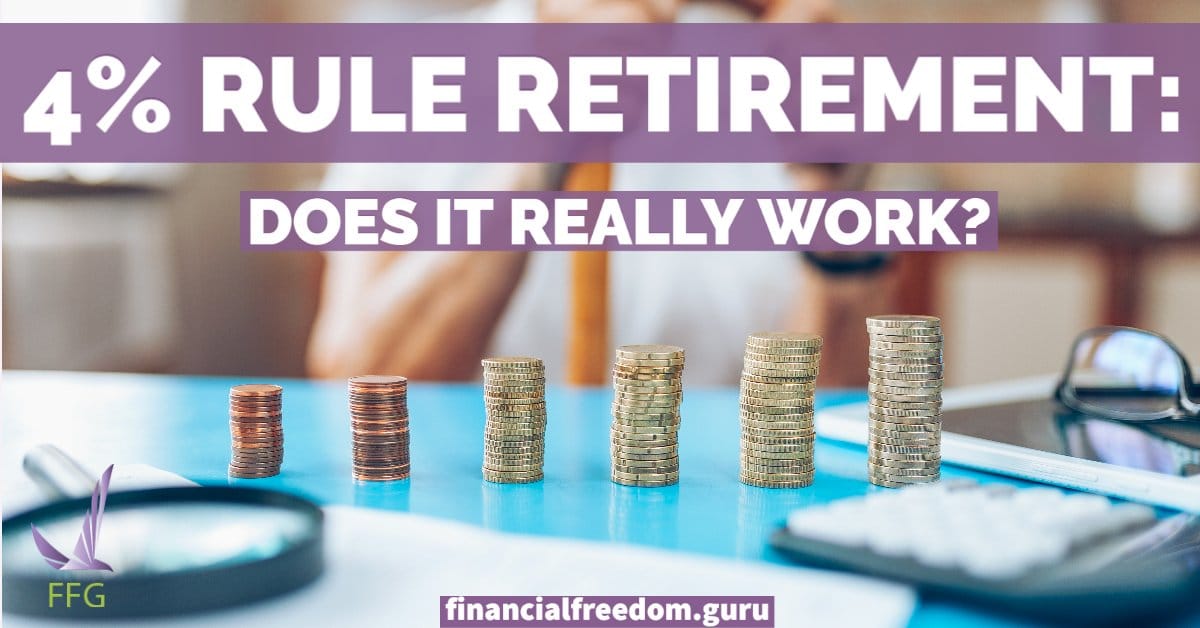4% Rule Retirement: Does It Work?

Anyone who has saved for retirement knows it takes willpower and good planning, but the effort should pay off when you’re ready to cash in on your savings.
Still, do you wonder how much you can afford to spend at a time in retirement?
Spending too much of your retirement savings early on may cause a shortfall later, but not spending enough can make retirement less enjoyable.
That’s why we’re discussing the 4% rule in retirement today!
Table of Contents
- What Is the “4% Rule Retirement”?
- Understanding the 4% Rule
- Planning for 30 Years of Retirement
- What Are the Pros and Cons of the 4% Rule?
- Does the 4% Rule Work in Current Market Conditions?
- What’s Better Than the 4% Rule for Retirement
- How About the 4% Rule for Early Retirees?
- The Bottom Line About “4% Rule Retirement”
What Is the “4% Rule Retirement”?
Many retirees in recent decades have used the 4% rule to decide how much they can afford to take from their retirement fund yearly.
The idea behind the 4% rule is that retirees can enjoy an annual income while their retirement fund keeps increasing in future value. Any money they take out in a year is primarily interest and dividends made on their savings.
Here’s our no-nonsense explanation of the 4% rule:
- The 4% rule means that you can withdraw 4% of your total retirement assets annually as income.
- It was created to guide retirees towards a safe and steady income that meets their current financial needs and future demands.
- Experts analyzed fifty years of historical stock and bond market data (from 1926 to 1976) in creating this rule.
Now that we’ve defined the 4% rule let’s understand its place in retirement planning.
Understanding the 4% Rule
Using the 4% rule may help you to plan during two critical times before retirement:
- Income Earning Years: While you’re in your income-earning years, it’s good to determine how much is necessary to retire comfortably. The intention is that you don’t run out of money, and your income rises yearly in step with inflation.
- Just Before Retirement: As you approach retirement, the 4% rule may provide a safer estimate of how much you can spend yearly, although it’s also wise to have an emergency fund for unexpected health or welfare situations—we’ll discuss that next.
Planning for 30 Years of Retirement

Retirement saving and pension planning
The life expectancy of any retiree is a critical factor in determining their sustainable income.
Investment planners generally suggest that retirees plan for a 30-year retirement period, but they caution that it’s possible to run out of savings in a worst-case scenario.
That’s why we should consider the 4% rule a “helpful guideline” and not a “rigid rule.” Here’s an example of what we mean:
- If you have $1 million saved upon your retirement, 4% of your total assets means you can spend $40,000 in one year.
- Experts tested the 4% rule to include an “emergency fund” that equaled 4.5% of total assets in a given year, and the rule remained adequate for the lifespan of the retiree’s savings.
What Are the Pros and Cons of the 4% Rule?
Because life has unknowns, no particular financial plan or rule can be guaranteed, including the 4% rule for retirement. Here are its pros and cons:
Pros
- It’s an easy rule to understand and use in planning.
- Until recent decades, the rule offered a safe and steady annual income and no shortage of funds if emergencies didn’t happen.
Cons
- In the 21st century, some experts see the rule as outdated.
- It may no longer guarantee that you won’t experience a shortfall of cash during retirement.
Do you remember us telling you earlier that the 4% rule is based on stock market data from 1926 to 1976?
While financial analysts, including William Bengen, used historical data to create the 4% rule in 1994, many 21st century experts question if the 4% rule still works since the earlier data is almost 100 years old.
Does the 4% Rule Work in Current Market Conditions?
Experts like retirement researcher Professor Wade Pfau think the 4% rule is too old to work in today’s financial markets.
Here’s why:
- The 4% rule hasn’t gotten adjusted to changing conditions in today’s financial markets, including lower-than-expected returns.
- When a retiree withdraws 4% of their total retirement savings in year one, the 4% rule assumes that their investment portfolio increases with COLA (cost of living adjustments) in the following years. But this is no longer guaranteed.
The 4% Rule Isn’t Dynamic
Additionally, the 4% rule isn’t “dynamic” enough. It doesn’t reflect today’s spending habits, including traveling during early retirement, taking up new hobbies, doing home improvements, or other personal activities.
Because retirees also live longer now, more serious medical expenses can set in later in retirement.
What’s Better Than the 4% Rule for Retirement
Recent financial articles suggest that the 4% rule should be relabelled as the 3.3% rule. Consider these points from financial experts in retirement savings:
- What Is Your Investment Strategy: Are you a conservative investor or a risk taker?
- What Is Your Comfort Level: Life can present you with unexpected challenges, and a lower rate of withdrawal from your investments is a safer bet than higher spending.
- How Flexible Are You? Can you adjust your spending if the financial markets experience a significant downturn?
- At and After Retirement: If your investment portfolio experiences lower returns upon your retirement, it creates a domino effect of lower savings into your future. Can you cope?
How About the 4% Rule for Early Retirees?
It’s a financial rule of thumb that the earlier you plan for retirement, the better off you’ll be. But the 4% rule was designed for people retiring at age 65. Your long-term financial goals are different when you retire earlier.
The Bottom Line About “4% Rule Retirement”
As life provides us with no guarantees, there is no financial rule to ensure you’ll be worry-free with your retirement savings.
The 4% rule for retirement was designed using older financial assumptions regarding interest-earning from bond investments. It’s a simple approach but not necessarily the best approach anymore.
We think it’s a great idea to understand the 4% rule as a starting point in your retirement planning. Then, when you know that the rule has its limitations, you can plan for dynamic spending during your retirement in an equally dynamic retirement plan!

![Gas stations that do cashback [2024]](https://financialfreedom.guru/wp-content/uploads/2024/01/Gas-stations-that-do-cashback-2024.jpeg)


